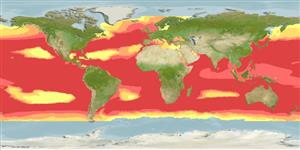Common names from other countries
分类 / Names
俗名 | 同种异名 | Catalog of Fishes(属, 种) | ITIS | CoL | WoRMS | Cloffa
Elasmobranchii
板鳃亚纲 (鲨鱼与 鱼) (sharks and rays) >
Carcharhiniformes (Ground sharks)
白眼鮫目 (Ground sharks) >
Carcharhinidae (Requiem sharks)
白眼鮫科 (Requiem sharks)
Etymology: Prionace: prion (Gr.), saw; akis (Gr.), point or barb, referring to serrated (saw-like) cusps on teeth of upper jaw. (See ETYFish); glauca: Latin for bluish green or gray (i.e., sea-colored), referring to its color (blue above, whitish below). (See ETYFish).
More on author: Linnaeus.
Environment: milieu / climate zone / depth range / distribution range
生态学
海洋; 半咸淡水; 海洋洄游的 (Ref. 51243); 深度上下限 0 - 1082 m (Ref. 89422), usually 1 - 220 m (Ref. 55193). 亞熱帶的; 7°C - 21°C (Ref. 244); 70°N - 55°S, 180°W - 180°E
Circumglobal in temperate and tropical waters. Western Atlantic: Newfoundland, Canada to Argentina. Central Atlantic. Eastern Atlantic: Norway to South Africa, including the Mediterranean. Indo-West Pacific: East Africa to Indonesia, Japan, Australia, New Caledonia, and New Zealand. Eastern Pacific: Gulf of Alaska to Chile. Probably the widest ranging chondrichthyian. Highly migratory species.
環球分佈於溫帶與熱帶的水域。 西大西洋: 加拿大紐芬蘭到阿根廷。 中大西洋。 東大西洋: 挪威到南非, 包括地中海。 印度-西太平洋: 東非到印尼,日本,澳洲,新加勒多尼亞與紐西蘭。 東太平洋: 阿拉斯加灣到智利。 可能最寬的分佈軟骨魚。 高度遷移的種,1982年海事法會議的附件一.(參考文獻 26139)
Length at first maturity / 大小 / 重量 / 年龄
Maturity: Lm 199.1, range 170 - 221 cm
Max length : 400 cm TL 雄鱼/尚未辨别雌雄; (Ref. 35388); common length : 335 cm TL 雄鱼/尚未辨别雌雄; (Ref. 5217); 最大体重: 205.9 kg (Ref. 40637); 最大年龄: 20 年 (Ref. 27347)
背棘 (总数) : 0; 臀棘: 0. A slim, graceful blue shark with a long, conical snout, large eyes, and curved triangular upper teeth with saw edges; pectorals long and narrow; no interdorsal ridge (Ref. 5578). Dark blue dorsally, bright blue on the sides, white ventrally (Ref. 5578). Tips of pectoral fins and anal fin dusky (Ref. 9997). The first case of diprosopus tetrophthalmus (cranofacial duplication) in a foetus of this species was reported from South Atlantic (Ref. 119190).
瘦又优美的蓝色鲨鱼有一个长的, 锥形吻又大的眼 , 与弯曲的三角形的上颚齿具有锯齿边; 胸鳍长而狭窄的; 没有间背脊.(参考文献 5578) 背面深蓝色,侧边淡蓝色,和腹侧白色的.(参考文献 5578) 胸鳍的顶端与臀鳍暗色的.(参考文献 9997)
Oceanic, but may be found close inshore where the continental shelf is narrow (Ref. 6871, 58302). Usually found to at least 150 m (Ref. 26938). Maximum size from Ref. 128029. Reported from estuaries (Ref. 26340). Epipelagic, occasionally occurs in littoral areas (Ref. 58302). Feeds on fishes (herring, silver hake, white hake, red hake, cod, haddock, pollock, mackerel, butterfish, sea raven and flounders (Ref. 5951)), small sharks, squids, pelagic red crabs, cetacean carrion, occasional sea birds and garbage (Ref. 5578). Viviparous (Ref. 50449). Sexual dimorphism occurs in skin thickness of maturing and adult females (Ref. 49562). May travel considerable distances (one specimen tagged in New Zealand was recaptured 1,200 km off the coast of Chile) (Ref. 26346). Potentially dangerous to humans (Ref. 6871, 13513). Marketed fresh, dried or salted, and frozen; meat utilized for consumption, hides for leather and fins for soup (Ref. 9987). Sexually mature at 250 cm long and 4-5 years old. The female gives birth up to 80 young measuring 40 cm long, gestation lasts almost a year (Ref. 35388). Produces from 4 to 135 young a litter (Ref. 26938). Minimum depth from Ref. 125614.
大洋性的, 但是可能被发现大陆架是狭窄的近岸.(参考文献 6871) 通常发现于到至少 150 公尺。 (参考文献 26938) 记录来自河口了。 (参考文献 26340) 吃硬骨鱼类,小的鲨鱼,乌贼,大洋性的红色螃蟹,鲸类的腐肉又偶然的海鸟与垃圾。 (参考文献 5578) 胎生的.(参考文献 50449) 性的同种二形出现于成熟的皮肤厚度中与雌性成鱼.(参考文献 49562) 五月旅行相当多的距离 (在新西兰被附以签条的一件标本公里外海的智利海岸被拿回 1,200) 。 (参考文献 26346) 可能对人类具有危险性.(参考文献 6871,13513) 在市场上销售新鲜的,乾燥或盐腌, 与冷冻; 肉利用了消费,皮用做皮革与鳍用于汤。 (参考文献 9987) 在 250 时性成熟公分长与 4-5 年之久。 母鱼生产向上到 80个幼鱼长度40 公分长, 妊娠几乎持续一年.(参考文献 35388) 生产品从 4 对 135个幼鱼一胎.(参考文献 26938)
Distinct pairing with embrace (Ref. 205). Viviparous (Ref. 26281), placental (Ref. 50449); 4-63 young in a litter (Ref. 9997); 4-135 (usually 15-30) pups (Ref.58048), about 35-44 cm at birth. Gestation period ranges from 9 to 12 months (Ref. 244).
Sexual dimorphism is evident in skin thickness of maturing and adult females (Ref. 49562). Females have thicker skin layer than males of the same size (Ref. 49562).環球分佈於溫帶與熱帶的水域。 西大西洋: 加拿大紐芬蘭到阿根廷。 中大西洋。 東大西洋: 挪威到南非, 包括地中海。 印度-西太平洋: 東非到印尼,日本,澳洲,新加勒多尼亞與紐西蘭。 東太平洋: 阿拉斯加灣到智利。 可能最寬的分佈軟骨魚。 高度遷移的種,1982年海事法會議的附件一.(參考文獻 26139)
Compagno, L.J.V., 1984. FAO Species Catalogue. Vol. 4. Sharks of the world. An annotated and illustrated catalogue of shark species known to date. Part 2 - Carcharhiniformes. FAO Fish. Synop. 125(4/2):251-655. Rome: FAO. (Ref. 244)
世界自然保护联盟红皮书 (Ref. 130435)
临近濒危 (NT) (A2bd); Date assessed: 06 November 2018
人类利用
渔业: 低经济; 游钓鱼种: 是的
工具
特别资料
下载 XML
网络资源
Estimates based on models
Preferred temperature (Ref.
115969): 5.9 - 25.2, mean 14.8 (based on 1945 cells).
Phylogenetic diversity index (Ref.
82804): PD
50 = 1.0000 [Uniqueness, from 0.5 = low to 2.0 = high].
Bayesian length-weight: a=0.00447 (0.00371 - 0.00538), b=3.10 (3.05 - 3.15), in cm Total Length, based on LWR estimates for this species (Ref.
93245).
营养阶层 (Ref.
69278): 4.4 ±0.2 se; based on diet studies.
回复力 (Ref.
120179): 低的, 最小族群倍增时间4.5 - 14 年 (rm=0.031; K=0.16; tm=6; tmax=20; Fec=4-135).
Prior r = 0.19, 95% CL = 0.12 - 0.28, Based on 9 full stock assessments.
Fishing Vulnerability (Ref.
59153): High to very high vulnerability (73 of 100).
Climate Vulnerability (Ref.
125649): High vulnerability (57 of 100).
